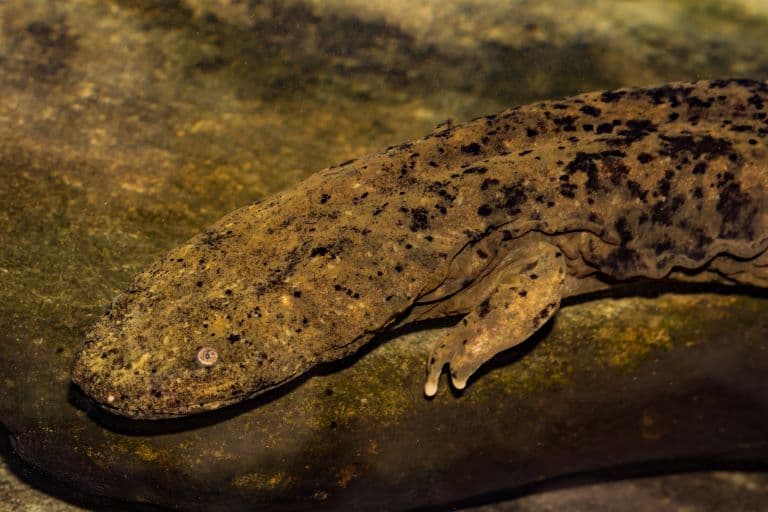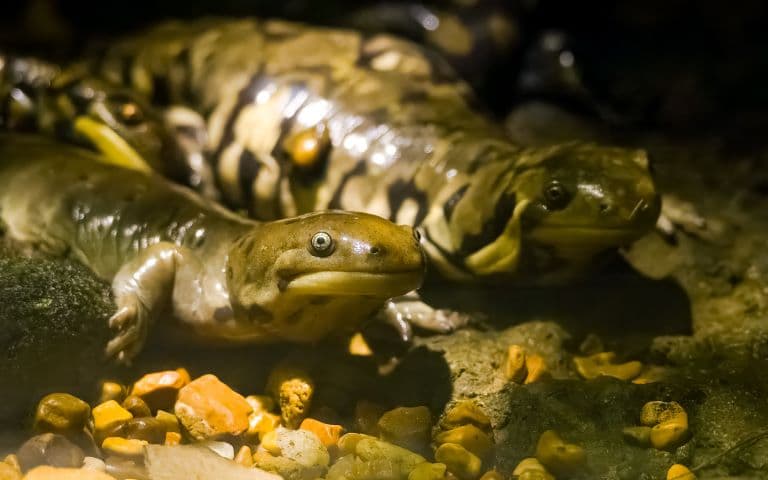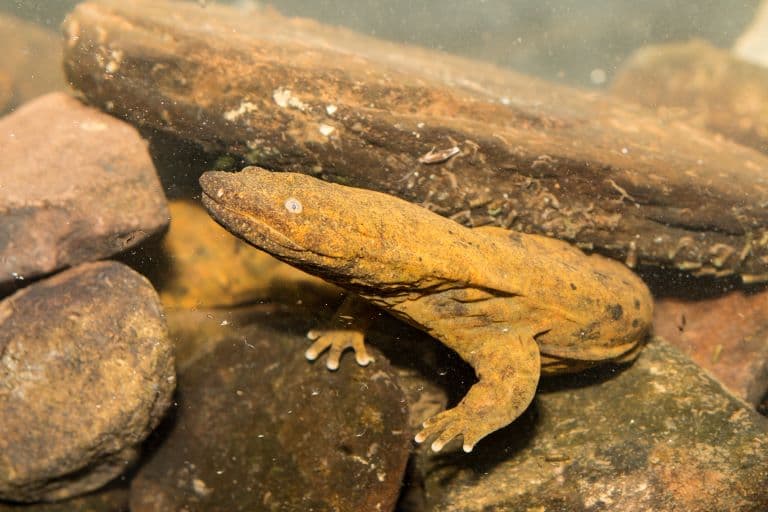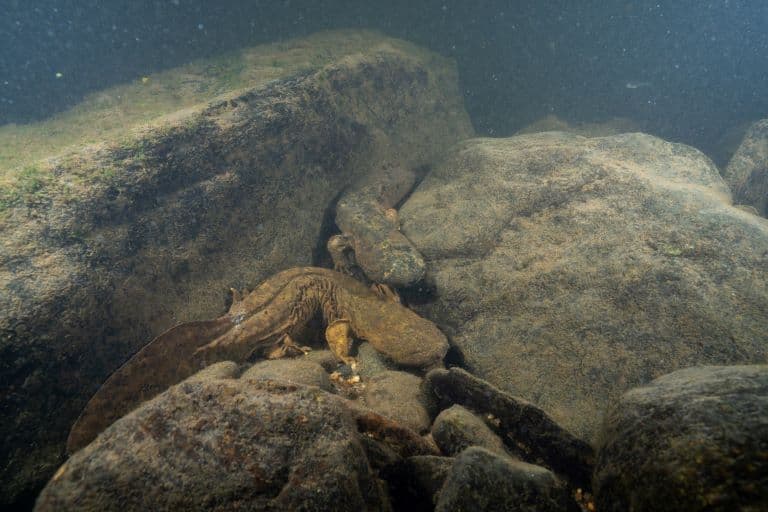Hellbender Salamander Profile
The hellbender salamander, or just hellbender, is a fully aquatic, large amphibian with a range that encompasses parts of North America including New York, Illinois, Mississippi and areas of Alabama and Georgia. 1
It is the largest salamander found in America and is located in fast moving freshwater rivers and streams. Hellbenders are usually found in very clean water that is well oxygenated and that also contains many rocks, logs or other such items to aid in concealment and protection.
The hellbender has a long flat body with short legs keeping it low to the ground. Its head is also flattened with small beady eyes (with no eyelids) and a long tail that acts like a rudder and helps give it good propulsion in the water.
They often walk up and down streams, using pads on their toes to help grip rocks, stones and other substrates. Males are generally slightly bigger and broader than females. Their skin colour can vary from, grey to brown to red and even black, with mottled markings on their tops and sides and a lighter skin colour underneath. 2

Hellbender Salamander Facts Overview
| Habitat: | Mountain streams/rivers |
| Location: | Eastern North America |
| Lifespan: | Up to 25 years in the wild |
| Size: | 30-74cm long |
| Weight: | Up to 2.2kg |
| Color: | They vary from shades of grey to brown and some are nearly totally black. Some areas on the back and sides are mottled. |
| Diet: | Crayfish, worms, small fish |
| Predators: | Juveniles are predated upon by fish, turtles, snakes Adults can be predated upon by river otters, raccoon, mink |
| Top Speed: | Not known |
| No. of Species: |
1 species, 2 sub-species |
| Conservation Status: |
Near Threatened |
Hellbenders generally live a solitary life, apart from when it comes to the breeding season, where they come together in groups of ten or more. These salamanders will defend their particular sheltered spot in the water, however, this is only usually during times of breeding, where nesting sites become a priority.
Hellbenders become sexually mature at between 5-7 years of age. Females will lay their eggs in a ‘nest’ made by a male, this usually consists of two long strings, each comprising of 200-400 eggs that come together to form a yellow-ish ball in the nest.
The male then fertilises these and takes care of the nest, defending it for just over two months until the larvae hatch out. The male helps oxygenate the eggs by moving delicately on top of them.
Larvae have gill slits and do not have functional limbs. As they mature their limbs grow and their gill slits begin to close up until they are eventually just a small opening at adulthood. This is usually at around 2 years old.
This amphibian is nocturnal and carries out most activities, such as feeding, at night. During the day they will take shelter under large rocks or logs to avoid being predated upon. During the night they will sit and wait to ambush their prey.
They keep their bodies hidden with only their heads visible (although still relatively camouflaged due to their skin colour and texture) and wait for something that takes their fancy to pass by, opening their large mouths wide to capture it. Crayfish are consumed the most frequently, however smaller fish and invertebrates make up part of their diet too. 3
Interesting Hellbender Salamander Facts
1. They have lungs but they don’t really use them
They have vestigial lungs, meaning that they don’t really use them. Instead they have flaps of loose skin or frills on their sides that absorb oxygen from the water that they are in. 95% of their oxygen is absorbed through their skin. They mainly use their lungs to help keep them buoyant in the water.

2. The hellbender is slimy
They have a mucus all over their bodies which is distasteful to predators. It also acts as a protective layer to the skin, especially to cuts and scrapes and also parasites and disease. They can also release a milky substance from their skin when threatened which also acts as a predator deterrent.
3. Males make nests
Before the breeding season, males will dig out a ‘nest’ under a rock for females to eventually lay her eggs into. Females are sometimes attracted to these excavated sites or males will nudge them into them.
4. The hellbender salamander has many names
They can be known by many names. Some of them include; snot otter, lasagna lizard, devil dog, mud-devil, mud dog, water dog, and leverian water newt.

5. Many juvenile hellbenders die in the early stages of life
When juvenile hellbenders hatch they are only about 2.5-3cm long. They no longer have parents to guard them and mortality rates are high, often being eaten by fish, turtles and even snakes.
6. Hellbenders need a clean environment
Pollution in waters poses a big threat to this salamander, particularly as they take in oxygen through their skin and it is so sensitive to the surrounding water. Scientists believe that declining water quality in this salamander’s habitat is directly linked to declining hellbender numbers.
7. There are two sub-species of Hellbender
There is the Eastern hellbender and the Ozark hellbender. Both sub-species have suffered a serious decline in numbers over the past 30-40 years, in particular the Ozark sub-species.
8. Hellbenders can get bad skin conditions
In general this salamander is quite prone to disease, in particular skin disease. In some parts of its range some hellbenders have been seen missing foot tissue, with only bone exposed. It was originally thought that a fungus might be causing this, even found in the crayfish that they eat but this was proved wrong and it is still being investigated.
9. Scientists are raising hellbenders in captivity
Because hellbender numbers have been decreasing since the 1980s and the situation had become pretty severe with numbers in the wild, scientists decided to start breeding them in captivity. Once they have reached around 23cm long they are then released into wild rivers and streams (although currently with differing success rates).
10. They need all the folds in their skin to help them breathe
Hellbenders absorb oxygen in the water through their skin. Having lots of wrinkles or folds in their skin increases its surface area, helping maximise the amount of oxygen they take in.
11. Sometimes parents will eat their own eggs
It has been observed that males and females will sometimes eat some eggs as a food source, but it is only usually a few!
12. Their territory is determined by a rock
A hellbender will base the majority of the activities it undertakes around the rock that it lives under and that gives it shelter. Territories can overlap but this doesn’t tend to happen as they do not live in dense populations.

13. A hellbender is a host to many things
Leeches, parasitic worms, tape worms, nematodes and spiney-headed worms have all been found inside this salamander.
14. They have a Jacobson’s organ
The Jacobson’s organ is a canal found in the snout of the hellbender that helps it take in chemical signals from its surroundings. They also have receptors on their body to help interpret amounts of light, pressure and also vibrations in the water.
Hellbender Salamander Fact-File Summary
Scientific Classification
| Kingdom: | Animalia |
| Phylum: | Chordata |
| Class: | Amphibia |
| Order: | Urodela |
| Family: | Cryptobranchidae |
| Genus: | Cryptobranchus |
| Species Name: |
Cryptobranchus alleganiensis alleganiensis – Eastern Hellbender
Cryptobranchus alleganiensis bishopi – Ozark Hellbender |
Fact Sources & References
- JANE J. LEE (2013), “U.S. Giant Salamanders Slipping Away: Inside the Fight to Save the Hellbender”, National Geographic.
- “HELLBENDER”, Smithsonian’s National Zoo & Conservation Biology Institute.
- “Hellbender Cryptobranchus alleganiensis”, The National Wildlife Federation.
